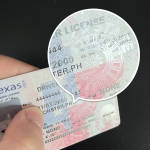What Constitutes a Real ID System?
A Real ID system refers to a structured framework designed to confirm an individual’s identity using verifiable, government-issued documentation. These systems typically rely on physical or digital credentials such as driver’s licenses, passports, or national ID cards, each embedded with unique identifiers—like holograms, barcodes, or RFID chips—to prevent tampering. Traditional verification processes under Real ID involve manual checks by personnel, who compare the photo and details on the ID with the person in front of them. While effective, these methods face limitations: human error, time consumption, and vulnerability to sophisticated forgeries.
For instance, in airport security, agents spend minutes cross-referencing boarding passes with IDs, creating bottlenecks. In financial services, opening a bank account may require multiple document submissions, delaying onboarding. These inefficiencies highlight the need for systems that can streamline verification without compromising accuracy.
Augmented Reality: Redefining Verification Processes
Augmented Reality (AR) bridges the physical and digital worlds by overlaying computer-generated information onto real-world environments. When applied to ID verification, AR transforms static checks into interactive, data-rich experiences. Using cameras on smartphones, tablets, or smart glasses, AR applications can scan an ID, extract its details, and project relevant data—such as expiration dates, security features, or biometric templates—directly onto the user’s view.
Consider a scenario where a retail store employee uses an AR-enabled device to scan a customer’s ID. The device instantly retrieves the ID’s issuing authority database, verifies the hologram’s authenticity through 3D mapping, and cross-checks the holder’s facial features against stored biometrics. All this happens in seconds, with discrepancies flagged in real time. This reduces reliance on human judgment and accelerates transaction times.
Technical Foundations of AR-Assisted Real ID Verification
The integration of AR with Real ID systems hinges on several key technologies:
- Computer Vision: Algorithms analyze visual data from ID documents, detecting patterns, text, and security features. For example, they can identify microprinting (tiny text visible only under magnification) or watermarks that counterfeiters often miss.
- 3D Spatial Mapping: AR devices create a 3D model of the ID, allowing verification systems to check for physical anomalies like raised lettering or layered materials, which are hard to replicate.
- Biometric Matching: AR overlays facial recognition data onto the user’s face, comparing it to the photo on the ID. Some systems even integrate liveness detection to ensure the person is present (e.g., by asking them to blink or tilt their head).
- Cloud Integration: Scanned ID data is encrypted and sent to secure databases for real-time validation, ensuring access to the latest records (e.g., if an ID has been reported lost or stolen).
These technologies work in tandem to create a multi-layered verification process, making it exponentially harder for fraudsters to bypass checks.
Operational Benefits in Diverse Sectors
The adoption of AR-assisted Real ID verification is already showing tangible benefits across industries:
Travel and Transportation
Airports and border checkpoints are early adopters. AR-enabled kiosks allow passengers to scan their passports, have their faces matched to the document, and receive instant clearance. This reduces wait times from minutes to seconds, enhancing both security and traveler experience.
Financial Services
Banks and fintech companies use AR to verify customers remotely. A user can hold their ID up to a smartphone camera; the AR app extracts details, checks against government databases, and matches facial features—all without visiting a branch. This speeds up account opening and loan approvals.
Retail and Age-Restricted Sales
Stores selling alcohol, tobacco, or age-gated products use AR to confirm customers’ ages. An employee scans the ID, and the AR system highlights the birthdate, expiration date, and any signs of tampering, ensuring compliance with legal requirements.
Addressing Common Concerns and Challenges
While AR-assisted verification offers promise, it also raises practical questions. Below are five common issues and actionable solutions:
1. “How does AR handle low-quality or damaged ID documents?”
Issue: Wear and tear, smudges, or partial damage can make traditional scanners fail to read IDs.
Solution: Advanced AR systems use machine learning to fill in missing data. For example, if a barcode is partially obscured, the algorithm can reconstruct it by referencing known patterns from the issuing authority’s database. Additionally, 3D mapping captures the physical texture of the ID, allowing the system to distinguish between a damaged genuine ID and a poorly made forgery.

2. “Can AR systems detect sophisticated counterfeit IDs?”
Issue: Modern forgeries may replicate holograms or barcodes, making them hard to spot with the naked eye.
Solution: AR verification employs multi-factor checks. Beyond visual scanning, systems analyze the ID’s material properties (e.g., thickness, UV reactivity) using specialized sensors. For instance, some AR devices include UV lights that reveal hidden security threads not visible under normal light. These layers of validation make it nearly impossible for counterfeiters to replicate all features accurately.
3. “What privacy risks are associated with AR ID verification?”
Issue: Storing biometric or ID data digitally raises concerns about data breaches.
Solution: Leading AR systems use end-to-end encryption, ensuring data is scrambled during transmission and storage. Many also implement “zero-trust” architectures, where data is only processed temporarily and never stored unless explicitly required by law. Additionally, user consent is prioritized—systems often prompt users to approve data sharing before initiating verification.
4. “Do users need expensive devices to use AR-assisted verification?”
Issue: Perceptions that AR requires specialized hardware (e.g., smart glasses) may limit adoption.
Solution: Most AR verification applications are built for mainstream smartphones, which already have the necessary cameras and processing power. Web-based AR (using browsers like Chrome or Safari) further reduces barriers, as users don’t need to download apps. For businesses, low-cost clip-on accessories (e.g., UV filters for smartphones) can enhance existing devices without significant investment.

5. “How reliable is AR in varying lighting conditions?”
Issue: Poor lighting (e.g., dim indoor settings or harsh sunlight) can distort ID scans.
Solution: AR algorithms are designed to adapt to lighting variations. For example, dynamic exposure adjustments brighten dark areas or reduce glare in real time. Some systems also use depth-sensing cameras (available on newer smartphones) to capture 3D data, which is less affected by lighting than 2D images. In cases of extreme lighting, the system may prompt the user to reposition the ID or switch to a manual override with guided instructions.



